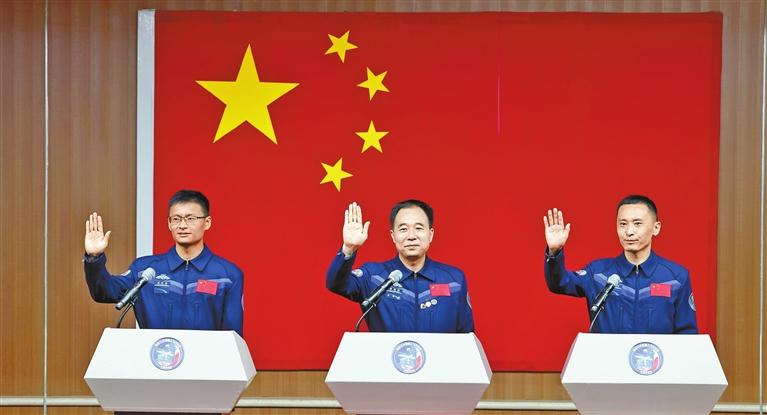
Shenzhou-16 crew Jing Haipeng (C), Zhu Yangzhu (R) and Gui Haichao meet the press at the Jiuquan Satellite Launch Center in Northwest China yesterday. Xinhua
China plans to realize manned lunar landing by 2030, the China Manned Space Agency (CMSA) announced at a press conference at the Jiuquan Satellite Launch Center in Northwest China yesterday.
Lin Xiqiang, deputy director of the CMSA, told reporters China has recently initiated the lunar landing phase of its manned lunar exploration program.
The overall goal is to achieve China’s first manned landing on the moon by 2030 and carry out lunar scientific exploration and related technological experiments, he added.
According to Lin, the goal also includes mastering the key technologies such as Earth-moon manned roundtrip, lunar surface short-term stay and human-robot joint exploration, accomplishing multiple tasks of landing, roving, sampling, researching and returning, and forming an independent capability of manned lunar exploration.
China’s manned lunar landing will promote the leapfrog development of manned space technology from near-Earth to deep space, deepen human understanding of the origin and evolution of the moon and the solar system, and contribute Chinese wisdom to the development of lunar science, he said.
The CMSA has carried out various research and development work to achieve the goal on the basis of preliminary key technology research and program demonstration, including the research and development of the new-generation manned launch vehicle Long March-10, new-generation manned spaceship, lunar lander and lunar landing suits, as well as the building and testing of a new launch site, facilities and equipment.
The CMSA will release announcements later to solicit proposals for scientific payloads and manned lunar rover, and for names of new-generation manned spaceship and lunar lander, according to Lin.
Shenzhou-16 mission’s tasks
At the conference, the CMSA announced the Shenzhou-16 crewed spaceship is scheduled to be launched at 9:31 a.m. today (Beijing Time) from the Jiuquan Satellite Launch Center in Northwest China.
Shenzhou-16 is the second flight mission of China’s manned space program this year, and the first crewed mission after China’s space station entered the application and development stage.
After entering orbit, the spaceship will perform a fast automated rendezvous and docking with the radial port of the space station core module Tianhe, forming a combination with three modules and three spacecraft, Lin said.
The three Shenzhou-16 astronauts are expected to make high-level scientific achievements in the study of novel quantum phenomena, high-precision space time-frequency systems, the verification of general relativity, and the origin of life, Lin said.
The Shenzhou-16 mission will also install electric propulsion cylinders and lift extravehicular cameras.
In addition, this mission will complete the installation of large extravehicular application facilities such as radiation biological exposure experiment equipment, he said.
The Shenzhou-16 crew will witness the dockings of the Tianzhou-5 cargo craft and the Shenzhou-17 crewed spaceship, as well as the departures of the Shenzhou-15 manned spaceship and Tianzhou-5, he said.
They will stay in orbit for about five months, and will return to the Dongfeng landing site in North China’s Inner Mongolia Autonomous Region in November this year.
Foreign astronauts welcome
China is looking forward to and welcomes the participation of foreign astronauts in the country’s space station flight missions, Lin said.
During the development and construction of China’s space station, the country has carried out various forms of exchanges and cooperation with many foreign space agencies and international organizations.
In addition, China has been actively engaged in discussions and the making of regulations pertaining to issues like space environment governance, space traffic management, and the development and utilization of space resources. These efforts have contributed to addressing common challenges of humankind in outer space, he said.
With a complete near-Earth manned space station, a manned shuttle transportation system, and a comprehensive framework for selecting, training and supporting taikonauts, China is now able to carry out crewed missions on a regular basis with a frequency of twice a year.
Shenzhou-15 mission smooth
The Shenzhou-15 astronauts have been working and living in-orbit for 181 days.
They have successfully completed four extravehicular activities (EVAs), becoming the crew to accomplish the most frequent EVAs of all Chinese crews to date, Lin said.
They have conducted eight human factors engineering research activities, 28 space medical experiments and 38 space science experiments covering life ecology, material science and fluid mechanics, and obtained valuable experimental data.
Astronauts on long-term missions in orbit usually need about six months to recover after a mission, said Lin, adding that they can transfer to normal work and training and participate in the next round of crew selection if they pass the evaluation. Once selected, they usually go through about one to one and a half years of training to fly again.



